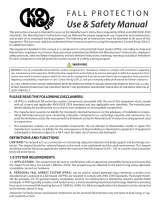
7
1.0 PRODUCT APPLICATION
1.1 PURPOSE: Flexiguard
®
Anchorage Systems are designed to provide anchorage connection points for a Personal Fall Arrest
System (PFAS).
WARNING: Unless otherwise noted, Capital Safety equipment is designed for use with Capital Safety approved components and
subsystems only. Substitution or replacement with non-approved components or subsystems may jeopardize compatibility of equipment
and may affect safety and reliability of the complete system. Do not hang, lift, or support tools or equipment from the Anchorage
System, or attach guy lines for antennas, phone lines, etc.
1.2 SUPERVISION: Installation of this equipment must be supervised by a Qualifi ed Person
1
. Use of this equipment must be
supervised by a Competent Person
4
.
1.3 TRAINING: This equipment must be installed and used by persons trained in its correct application. This manual is to be
used as part of an employee training program as required by OSHA. It is the responsibility of the users and installers of
this equipment to ensure they are familiar with these instructions, trained in the correct care and use of this equipment,
and are aware of the operating characteristics, application limitations, and consequences of improper use of this
equipment.
IMPORTANT: Training must be conducted without exposing the user to a fall hazard. Training should be repeated periodically.
1.4 RESCUE PLAN: When using this equipment and connecting subsystem(s), the employer must have a rescue plan and
the means at hand to implement and communicate that plan to users, authorized persons
2
, and rescuers
3
. A trained, on-
site rescue team is recommended. Team members should be provided with the equipment and techniques to perform a
successful rescue. Training should be provided on a periodic basis to ensure rescuer profi ciency.
1.5 INSPECTION FREQUENCY:
The Flexiguard
Anchorage System
shall be inspected by the user before each use and,
additionally, by a competent person
4
other than the user at intervals of no more than one year
5
. Inspection procedures
are described in the “Inspection and Maintenance Log” (Table 2). Results of each Competent Person inspection should be
recorded on copies of the “Inspection and Maintenance Log”.
1.6 AFTER A FALL: If the Flexiguard Anchorage System is subjected to the forces of arresting a fall, it must be removed from
the fi eld of service immediately and replaced or inspected by an Authorized Capital Safety Representative.
2.0 SYSTEM CONSIDERATIONS
2.1 ANCHORAGE: Structure on which the Flexiguard Anchorage System is placed or mounted must meet the Anchorage
specifi cations defi ned in Table 1.
FROM OSHA: Anchorages used for attachment of Personal Fall Arrest Systems shall be independent of any anchorage being used
to support or suspend platforms, and capable of supporting at least 5,000 lbs (22 kN) per user attached, or be designed, installed, and
used as part of a complete Personal Fall Arrest System which maintains a safety factor of a least 2, and is under the supervision of a
qualifi ed person.
2.2 PERSONAL FALL ARREST SYSTEM: Figure 1 illustrates typical Fall Arrest applications of this Flexiguard
Anchorage System. Personal Fall Arrest Systems (PFAS) used with the system must meet applicable OSHA, ANSI, state,
and federal requirements. The PFAS shall incorporate a Full Body Harness and meet the following capabilities:
Maximim Arresting Force Maximum Free Fall Distance
PFAS with Shock Absorbing Lanyard 900 lb (4 kN) 6 ft (1.8 m)
Arresting Force Maximum Free Fall Distance
PFAS with Self Retracting Device 900 lb (4 kN) Maximum Arresting Force
or 900 lb (4 kN) Average Arresting
Force (as defi ned in ANSI Z359.14)
2 ft (0.61 m)
IMPORTANT: Under NO circumstances is a PFAS with a Free Fall distance greater than 6 ft (1.8 m) acceptable for use with the
Flexiguard Anchorage System.
2.3 FALL PATH AND SRL LOCKING SPEED: A clear path is required to assure positive locking of an SRL. Situations which
do not allow for an unobstructed fall path should be avoided. Working in confined or cramped spaces may not allow the
body to reach sufficient speed to cause the SRL to lock if a fall occurs. Working on slowly shifting material, such as sand
or grain, may not allow enough speed buildup to cause the SRL to lock.
2.4 HAZARDS: Use of this equipment in areas with environmental hazards may require additional precautions to prevent
injury to the user or damage to the equipment. Hazards may include, but are not limited to: heat, chemicals, corrosive
environments, high voltage power lines, explosive or toxic gases, moving machinery, sharp edges, or overhead materials
that may fall and contact the user or Personal Fall Arrest System.
1 Qualifi ed Person: A person with a recognized degree of professional certifi cate and with extensive knowledge, training, and experience in the fall protection
and rescue fi eld who is capable of designing, analyzing, evaluating, and specifying fall protections and rescue systems to the extent required by OSHA and other
applicable standards.
2 Authorized Person: For purposes of the Z359 standards, a person assigned by the employer to perform duties at a location where the person will be exposed
to a fall hazard.
3 Rescuer: Person or persons other than the rescue subject acting to perform an assisted rescue by operation of a rescue system.
4 Competent Person: One who is capable of identifying existing and predictable hazards in the surroundings or working conditions which are unsanitary, hazard-
ous, or dangerous to employees, and who has authorization to take prompt corrective measures to eliminate them.
5 Inspection Frequency: Extreme working conditions (harsh environments, prolonged use, etc.)may require increasing the frequency of competent person
inspections.





















